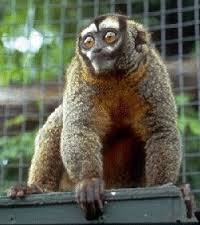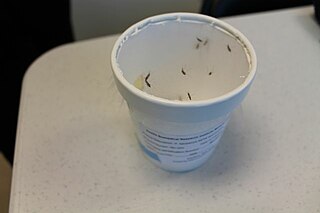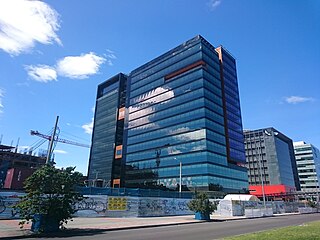
Night monkeys, also known as owl monkeys or douroucoulis, are nocturnal New World monkeys of the genus Aotus, the only member of the family Aotidae. The genus comprises eleven species which are found across Panama and much of South America in primary and secondary forests, tropical rainforests and cloud forests up to 2,400 metres (7,900 ft). Night monkeys have large eyes which improve their vision at night, while their ears are mostly hidden, giving them their name Aotus, meaning "earless".

The gray-bellied night monkey, also called the grey-legged douroucouli or lemurine owl monkey, is a small New World monkey of the family Aotidae. Native to tropical and subtropical forests of South America, the gray-bellied night monkey faces a significant threat from hunting, harvesting for use in pharmaceutical research and habitat destruction.

Nancy Ma's night monkey is a night monkey species from South America. It is found in Brazil and Peru. The species is named after Dr. Nancy Shui-Fong Ma.

Spix's night monkey, also known as the Colombian gray night monkey, noisy night monkey and Spix's owl monkey, is a night monkey species from South America. It is found in Brazil, Colombia, Ecuador and Peru.
A synthetic vaccine is a vaccine consisting mainly of synthetic peptides, carbohydrates, or antigens. They are usually considered to be safer than vaccines from bacterial cultures. Creating vaccines synthetically has the ability to increase the speed of production. This is especially important in the event of a pandemic.
Animal Defenders International (ADI), founded 1990, has offices in US, UK, Colombia, Peru and South Africa; education and public awareness campaigns to protect animals in captivity and wild animals and their environments. ADI 's campaigns focus on animals used in entertainment, sport, for clothing; illegal wildlife trade; and replacement of animals used in research and testing. ADI collaborates with governments on large-scale international rescues of wild animals following legislation to end animal circuses, illegal animal trafficking. ADI owns and operates the ADI Wildlife Sanctuary, South Africa, home to nearly 40 ex-circus lions and tigers from Peru, Colombia and Guatemala.

A malaria vaccine is a vaccine that is used to prevent malaria. The only approved malaria vaccine is RTS,S, known by the brand name Mosquirix. As of April 2022, the vaccine has been given to 1 million children living in areas with moderate-to-high malaria transmission. It requires at least three doses in infants by age 2, with a fourth dose extending the protection for another 1-2 years. The vaccine reduces hospital admissions from severe malaria by around 30%.

Science and technology in Colombia refers to the development of scientific research and technological innovation in Colombia, and how these in turn affect Colombian society, politics, and culture. Colciencias is a government agency that supports fundamental and applied research in Colombia.
Immunocontraception is the use of an animal's immune system to prevent it from fertilizing offspring. Contraceptives of this type are not currently approved for human use.
Stirtonia is an extinct genus of New World monkeys from the Middle Miocene. Its remains have been found at the Konzentrat-Lagerstätte of La Venta in the Honda Group of Colombia. Two species have been described, S. victoriae and the type species S. tatacoensis. Synonyms are Homunculus tatacoensis, described by Ruben Arthur Stirton in 1951 and Kondous laventicus by Setoguchi in 1985. The genus is classified in Alouattini as an ancestor to the modern howler monkeys.

The gray-handed night monkey is a species of night monkey formerly considered a subspecies of Gray-bellied night monkey of the family Aotidae. Its range consists of parts of Colombia and Venezuela. The exact classification of the gray-handed night monkey is uncertain. While some authors consider it a subspecies of the gray-bellied night monkey, A. lemurinus, other authors consider it a separate species, A. griseimembra.
Thomas R. Defler is a North American primatologist who lives and works in Colombia.

RTS,S/AS01 is a recombinant protein-based malaria vaccine. It is the only malaria vaccine approved and in wide use. As of April 2022, the vaccine has been given to 1 million children living in areas with moderate-to-high malaria transmission, with millions more doses to be provided as the vaccine's production expands. It requires at least three doses in infants by age 2, with a fourth dose extending the protection for another 1-2 years. The vaccine reduces hospital admissions from severe malaria by around 30%.

Naval Medical Research Unit Six (NAMRU-6) is a biomedical research laboratory of the US Navy located in Lima, Peru. It is the only US military command located in South America. Its mission is to identify infectious disease threats of military and public health importance and to develop and evaluate interventions and products to mitigate those threats.
Aotus dindensis is an extinct species of New World monkeys in the genus Aotus from the Middle Miocene. Its remains have been found at the Konzentrat-Lagerstätte of La Venta in the Honda Group of Colombia.

Hospital San Juan de Dios in Bogotá housed the National Institute of Immunology where important research on vaccines, notably the first synthetic vaccine against malaria, was conducted, The Instituto Meterno-infantil, Hospital La Hortúa and the Santa Clara Clinic currently. It is one of the oldest serving hospitals in Latin America. It was founded in 1723 in times of the colony, yet its operation dates back the 1564 and was called Hospital de San Pedro and was established with the properties donated by Bishop Juan de los Barrios. It was later called Hospital de Jesús, José y María and finally Hospital San Juan de Dios. It initially consisted of three buildings of republican architectural style. The main building was modeled after the Pasteur Institute in France. and was finished in 1921. Later, a 1960 style high-rise building was constructed to house the hospital, and the original buildings were left abandoned.
The immunome is the set of genes and proteins that constitute the immune system, excluding those that are widespread in other cell types, and not involved in the immune response itself. It is further defined as the set of peptides derived from the proteome that interact with the immune system. There are numerous ongoing efforts to characterize and sequence the immunomes of humans, mice, and elements of non-human primates. Typically, immunomes are studied using immunofluorescence microscopy to determine the presence and activity of immune-related enzymes and pathways. Practical applications for studying the immunome include vaccines, therapeutic proteins, and further treatment of other diseases. The study of the immunome falls under the field of immunomics.
Plasmodium brasilianum is a parasite that infects many species of platyrrhine monkeys in South and Central America.
Lagonimico is an extinct genus of New World monkeys from the Middle Miocene. Its remains have been found at the Konzentrat-Lagerstätte of La Venta in the Honda Group of Colombia. The type species is L. conclucatus.

S-268019-b is a protein subunit COVID-19 vaccine candidate developed by Shionogi.












